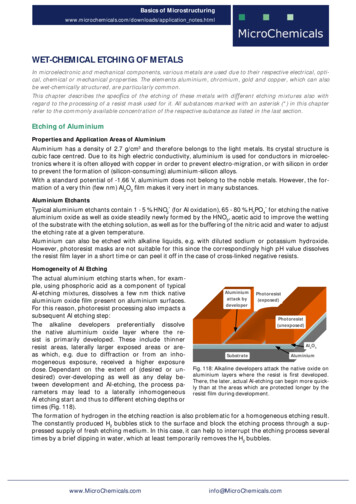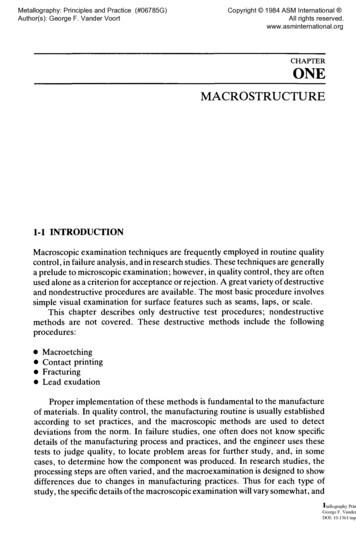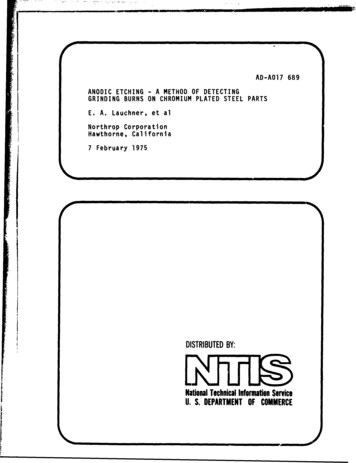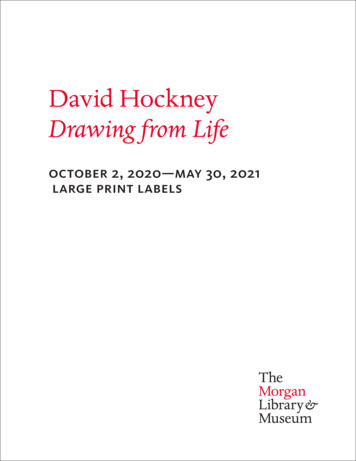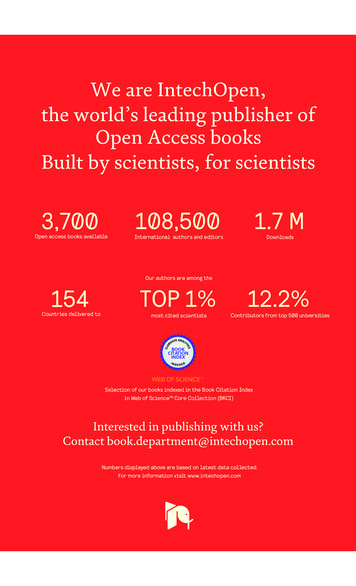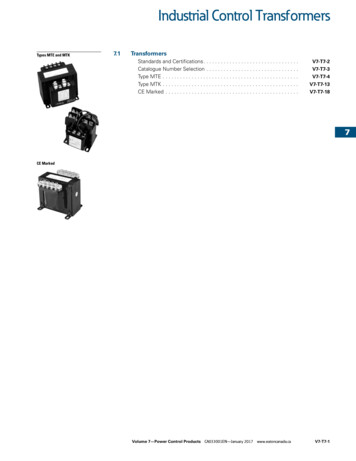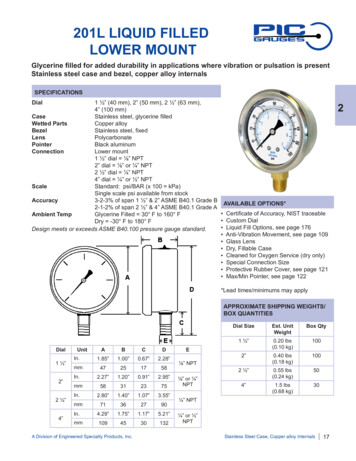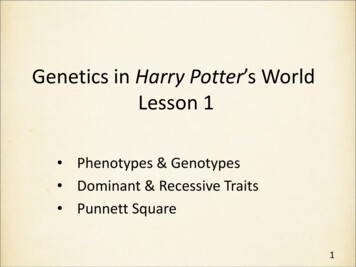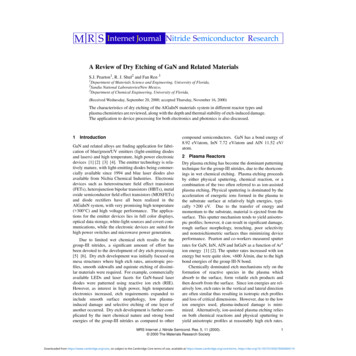
Transcription
MRSInternet Journal Nitride Semiconductor ResearchA Review of Dry Etching of GaN and Related MaterialsS.J. Pearton1, R. J. Shul2 and Fan Ren 31Departmentof Materials Science and Engineering, University of Florida,National Laboratories/New Mexico,3Department of Chemical Engineering, University of Florida,2Sandia(Received Wednesday, September 20, 2000; accepted Thursday, November 16, 2000)The characteristics of dry etching of the AlGaInN materials system in different reactor types andplasma chemistries are reviewed, along with the depth and thermal stability of etch-induced damage.The application to device processing for both electronics and photonics is also discussed.1IntroductionGaN and related alloys are finding application for fabrication of blue/green/UV emitters (light-emitting diodesand lasers) and high temperature, high power electronicdevices [1] [2] [3] [4]. The emitter technology is relatively mature, with light-emitting diodes being commercially available since 1994 and blue laser diodes alsoavailable from Nichia Chemical Industries. Electronicdevices such as heterostructure field effect transistors(FETs), heterojunction bipolar transistors (HBTs), metaloxide semiconductor field effect transistors (MOSFETs)and diode rectifiers have all been realized in theAlGaInN system, with very promising high temperature( 300 C) and high voltage performance. The applications for the emitter devices lies in full color displays,optical data storage, white-light sources and covert communications, while the electronic devices are suited forhigh power switches and microwave power generation.Due to limited wet chemical etch results for thegroup-III nitrides, a significant amount of effort hasbeen devoted to the development of dry etch processing[5] [6]. Dry etch development was initially focused onmesa structures where high etch rates, anisotropic profiles, smooth sidewalls and equirate etching of dissimilar materials were required. For example, commerciallyavailable LEDs and laser facets for GaN-based laserdiodes were patterned using reactive ion etch (RIE).However, as interest in high power, high temperatureelectronics increased, etch requirements expanded toinclude smooth surface morphology, low plasmainduced damage and selective etching of one layer ofanother occurred. Dry etch development is further complicated by the inert chemical nature and strong bondenergies of the group-III nitrides as compared to othercompound semiconductors. GaN has a bond energy of8.92 eV/atom, InN 7.72 eV/atom and AlN 11.52 eV/atom.2Plasma ReactorsDry plasma etching has become the dominant patterningtechnique for the group-III nitrides, due to the shortcomings in wet chemical etching. Plasma etching proceedsby either physical sputtering, chemical reaction, or acombination of the two often referred to as ion-assistedplasma etching, Physical sputtering is dominated by theacceleration of energetic ions formed in the plasma tothe substrate surface at relatively high energies, typically 200 eV. Due to the transfer of energy andmomentum to the substrate, material is ejected from thesurface. This sputter mechanism tends to yield anisotropic profiles; however, it can result in significant damage,rough surface morphology, trenching, poor selectivityand nonstoichiometric surfaces thus minimizing deviceperformance. Pearton and co-workers measured sputterrates for GaN, InN, AlN and InGaN as a function of Ar ion energy [1] [2]. The sputter rates increased with ionenergy but were quite slow, 600 Å/min, due to the highbond energies of the group III-N bond.Chemically dominated etch mechanisms rely on theformation of reactive species in the plasma whichabsorb to the surface, form volatile etch products andthen desorb from the surface. Since ion energies are relatively low, etch rates in the vertical and lateral directionare often similar thus resulting in isotropic etch profilesand loss of critical dimensions. However, due to the lowion energies used, plasma-induced damage is minimized. Alternatively, ion-assisted plasma etching relieson both chemical reactions and physical sputtering toyield anisotropic profiles at reasonably high etch rates.MRS Internet J. Nitride Semicond. Res. 5, 11 (2000). 2000 The Materials Research Society1Downloaded from https://www.cambridge.org/core, on subject to the Cambridge Core terms of use, available at https://www.cambridge.org/core/terms. https://doi.org/10.1557/S1092578300000119
Provided the chemical and physical component of theetch mechanism are balanced, high resolution featureswith minimal damage can be realized and optimumdevice performance can be obtained.2.1Reactive ion etching.RIE utilizes both the chemical and physical componentsof an etch mechanism to achieve anisotropic profiles,fast etch rates and dimensional control. RIE plasma aretypically generated by applying radio frequency (rf)power of 13.56 MHz between two parallel electrodes ina reactive gas [see Figure 1(a)]. The substrate is placedon the powered electrode where a potential is inducedand ion energies, defined as they cross the plasmasheath, are typically a few hundred eV. RIE is operatedat low pressures, ranging from a few mTorr up to 200mTorr, which promotes anisotropic etching due toincreased mean free paths and reduced collisional scattering of ions during acceleration in the sheath. Adesidaet al. were the first to report RIE of GaN in SiCl4-basedplasmas [6]. Etch rates increased with increasing dcbias, and were 500 Å/min at –400 V. Lin et al.,reported similar results for GaN in BCl3 and SiCl4 plasmas with etch rates of 1050 Å/min in BCl3 at 150 Wcathode (area 250 in.2) rf power [1] [2]. Additional RIEresults have been reported for HBr- [1] [2], CHF3- andCCl2F2-based [1] [2] plasmas with etch rates typically 600 Å/min. The best RIE results for the group-IIInitrides have been obtained in chorine-based plasmasunder high ion energy conditions where the III-N bondbreaking and the sputter desorption of etch productsfrom the surface are most efficient. Under these conditions, plasma damage can occur and degrade both electrical and optical device performance. Lowering the ionenergy or increasing the chemical activity in the plasmato minimize the damage often results in slower etchrates or less anisotropic profiles which significantly limits critical dimension. Therefore, it is necessary to pursue alternative etch platforms which combine highquality etch characteristics with low damage.2.2High-density plasmas.The use of high-density plasma etch systems includingelectron cyclotron resonance (ECR), inductively coupled plasma (ICP) and magnetron RIE (MRIE), hasresulted in improved etch characteristics for the groupIII nitrides as compared to RIE. This observation isattributed to plasma densities which are 2 to 4 orders ofmagnitude higher than RIE thus improving the III-Nbond breaking efficiency and the sputter desorption ofetch products formed on the surface. Additionally, sinceion energy and ion density can be more effectivelydecoupled as compared to RIE, plasma-induced damageis more readily controlled. Figure 1 (b) shows a sche2matic diagram of a typical low profile ECR etch system.High-density ECR plasmas are formed at low pressureswith low plasma potentials and ion energies due to magnetic confinement of electrons in the source region. Thesample is located downstream from the source to minimize exposure to the plasma and to reduce the physicalcomponent of the etch mechanism. Anisotropic etchingcan be achieved by superimposing an rf bias (13.56MHz) on the sample and operating at low pressure ( 5mTorr) to minimize ion scattering and lateral etching.However, as the rf biasing is increased the potential fordamage to the surface increases. Figure 2 shows a schematic of the plasma parameters and sample position in atypical high-density plasma reactor. Pearton and coworkers were the first to report ECR etching of group-IIInitride films []]. Etch rates for GaN, InN and AlNincreased as either the ion energy (dc bias) or ion flux(ECR source power) increased. Etch rates of 1100 Å/min for AlN and 700 Å/min for GaN at –150 V dc biasin a Cl2/H2 plasma and 350 Å/min for InN in a CH4/H2/Ar plasma at –250 V dc bias were reported. The etchedfeatures were anisotropic and the surface remained stoichiometric over a wide range of plasma conditions.GaN ECR etch data has been reported by several authorswith etch rates as high as 1.3 µm/min [1] [2] [5] [6].ICP offers another high-density plasma etch platform to pattern group-III nitrides. ICP plasmas areformed in a dielectric vessel encircled by an inductivecoil into which rf power is applied [see Figure 1 (c)].The alternating electric field between the coils induces astrong alternating magnetic field trapping electrons inthe center of the chamber and generating a high-densityplasma. Since ion energy and plasma density can beeffectively decoupled, uniform density and energy distributions are transferred to the sample while keepingion and electron energy low. Thus, ICP etching can produce low damage while maintaining fast etch rates.Anisotropy is achieved by superimposing of rf bias onthe sample. ICP etching is generally believed to haveseveral advantages over ECR including easier scale-upfor production, improved plasma uniformity over awider area and lower cost-of-operation. The first ICPetch results for GaN were reported in a Cl2/H2/Ar ICPgenerated plasma with etch rates as high as 6875 Å/min [7] . Etch rates increased with increasing dc biasand etch profiles were highly anisotropic with smoothetch morphologies over a wide range of plasma conditions. GaN etching has also been reported in a variety ofhalogen- and methane-based ICP plasmas [8]. Use of aCl2/Ar/O2 chemistry produced good selectivity for GaNand InGaN over AlGaN (up to 50), due to formation ofan oxide on the AlGaN [8].MRS Internet J. Nitride Semicond. Res. 5, 11 (2000). 2000 The Materials Research SocietyDownloaded from https://www.cambridge.org/core, on subject to the Cambridge Core terms of use, available at https://www.cambridge.org/core/terms. https://doi.org/10.1557/S1092578300000119
MRIE is another high-density etch platform which iscomparable to RIE. In MRIE, a magnetic field is usedto confine electrons close to the sample and minimizeelectron loss to the wall. Under these conditions, ionization efficiencies are increased and high plasma densitiesand fast etch rates are achieved at much lower dc biases(less damage) as compared to RIE. GaN etch rates of 3500 Å/min were reported in BCl3-based plasmas at dcbiases -100 V. The etch was fairly smooth and anisotropic.2.3Chemically-Assisted Ion Beam Etching.Chemically assisted ion beam etching (CAIBE) andreactive ion beam etching (RIBE) have also been used toetch group-III nitride films [6] [7]. In these processes,ions are generated in a high-density plasma source andaccelerated by one or more grids to the substrate. InCAIBE, reactive gases are added to the plasma downstream of the acceleration grids thus enhancing thechemical component of the etch mechanism, whereas inRIBE, reactive gases are introduced in the ion source.Both etch platforms rely on relatively energetic ions(200-2000 eV) and low chamber pressures ( 5 mTorr)to achieve anisotropic etch profiles. However, with suchhigh ion energies, the potential for plasma-induced damage exists. Adesida and co-workers reported CAIBEetch rates for GaN as high as 2100 Å/min with 500 eVAr ions and Cl2 or HCl ambients [6]. Rates increasedwith beam current, reactive gas flow rate and substratetemperature. Anisotropic profiles with smooth etchmorphologies were observed.2.4Reactive Ion Beam Etching.The RIBE removal rates for GaN, AlN and InN areshown in Figure 3 as a function of Cl2 percentage in Cl2/Ar beams at 400 eV and 100 mA current. The trend inremoval rates basically follows the bond energies ofthese materials. At fixed Cl2/Ar ratio, the ratesincreased with beam energy. At very high voltages, onewould expect the rates to saturate or even decrease dueto ion-assisted desorption of the reactive chlorine fromthe surface of the nitride sample before it can react toform the chloride etch products.There was relatively little effect of either beam current or sample temperature on the RIBE removal rates ofthe nitride. The etch profiles are anisotropic with lighttrenching at the base of the features. This is generallyascribed to ion deflection from the sidewalls causing anincreased ion flux at the base of the etched features.2.5Low Energy Electron Enhanced Etching.Low energy electron enhanced etching (LE4) of GaNhas been reported by Gilllis and co-workers [9]. LE4 isan etch technique which depends on the interaction oflow energy electrons ( 15 eV) and reactive species atthe substrate surface. The etch process results in minimal surface damage since there is negligible momentumtransferred from the electrons to the substrate. GaN etchrates of 500 Å/min in a H2-based LE4 plasma and 2500 Å/min in a pure Cl2 LE4 plasma have beenreported [9]. GaN has also been etched using photoassisted dry etch processes where the substrate is exposedto a reactive gas and ultraviolet laser radiation simultaneously. Vibrational and electronic excitations lead toimproved bond breaking and desorption of reactantproducts. GaN etch rates are compared in Figure 4 forRIE, ECR and ICP Cl2/H2/CH4/Ar plasmas as well as aRIBE Cl2/Ar plasma. CH4 and H2 were removed fromthe plasma chemistry to eliminate polymer deposition inthe RIBE chamber. Etch rates increased as a function ofdc bias independent of etch technique. GaN etch ratesobtained in the ICP and ECR plasmas were much fasterthan those obtained in RIE and RIBE. This was attributed to higher plasma densities (1-4 orders of magnitudehigher) which resulted in more efficient breaking of theIII-N bond and sputter desorption of the etch products.Slower rates observed in the RIBE may also be due tolower operational pressures (0.3 mTorr compared to 2mTorr for the ICP and ECR) and/or lower ion and reactive neutral flux at the GaN surface due to high sourceto-sample separation.33.1Plasma ChemistriesCl2-Based.Etch characteristics are often dependent upon plasmaparameters including pressure, ion energy and plasmadensity. As a function of pressure, plasma conditionsincluding the mean free path and the collisional frequency can change resulting in changes in both ionenergy and plasma density. GaN etch rates are shown asa function of pressure for an ICP-generated BCl3/Cl2plasma in Figure 5. Etch rates increased as the pressurewas increased from 1 to 2 mTorr and then decreased athigher pressures. The initial increase in etch rate suggested a reactant limited regime at low pressure, however at higher pressures the etch rates decreased dueeither to lower plasma densities (ions or radical neutrals), redeposition or polymer formation on the substrate surface. At pressures 10 mTorr, GaN etcheswere anisotropic and smooth, while at pressure 10mTorr the etch profile was undercut and poorly defineddue to a lower mean free path, collisional scattering ofthe ions and increased lateral etching of the GaN.GaN etch rates are plotted as a function of dc bias(which correlates to ion energy) for an ICP-generatedBCl3/Cl2 plasma in Figure 6. The GaN etch ratesincreased monotonically as the dc bias or ion energyMRS Internet J. Nitride Semicond. Res. 5, 11 (2000). 2000 The Materials Research Society3Downloaded from https://www.cambridge.org/core, on subject to the Cambridge Core terms of use, available at https://www.cambridge.org/core/terms. https://doi.org/10.1557/S1092578300000119
increased. Etch rates increased due to improved sputterdesorption of etch products from the surface as well asmore efficient breaking of the Ga-N bonds. Etch rateshave also been observed to decrease under high ionbombardment energies due to sputter desorption of reactive species from the surface before the reactions occur.This is often referred to as an adsorption limited etchregime. In Figure 7, SEM micrographs are shown for(a) –50, (b) –150 and (c) –300 V dc bias. The etch profile became more anisotropic as the dc bias increasedfrom –50 to –150 V dc bias due to the perpendicularpath of the ions relative to the substrate surface whichmaintained straight wall profiles. However, as the dcbias was increased to –300 V, a tiered etch profile withvertical striations in the sidewall was observed due toerosion of the resist mask edge. The GaN may becomerougher at these conditions due to mask redepositionand preferential loss of N2.In Figure 8, GaN etch rates are shown as a functionof ICP-source power while the dc bias was held constantat –250 V. GaN etch rates increased as the ICP sourcepower increased due to higher concentrations of reactivespecies which increases the chemical component of theetch mechanism and/or higher ion flux which increasesthe bond breaking and sputter desorption efficiency ofthe etch. Etch rates have also been observed to stabilizeor decrease under high plasma flux conditions due eitherto saturation of reactive species at the surface or sputterdesorption of reactive species from the surface beforethe reactions occur. The etch profile was anisotropicand smooth up to 1000 W ICP power where the featuredimensions were lost and sidewall morphology wasrough due to erosion of the mask edge under highplasma flux conditions. In addition to etch rates, etchselectivity or the ability to etch one film at higher ratesthan another can be very important in device fabrication.For example, optimization of etch selectivity is criticalto control threshold voltage uniformity for high electronmobility transistors (HEMTs), to accurately stop oneither the emitter or collector regions for metal contactsfor heterojunction bipolar transistors (HBTs), and forlow resistivity n-ohmic contacts on InN layers. Severalstudies have recently reported etch selectivity for thegroup-III nitrides [6] [7] [8]. For example, Figure 9shows GaN, InN and AlN etch rates and etch selectivities as a function of cathode rf power in an ICP-generated Cl2/Ar plasma. Etch rates for all three filmsincreased with increasing cathode rf power or dc biasdue to improved breaking of the III-N bonds and moreefficient sputter desorption of the etch products.Increasing InN etch rates were especially significantsince InCl3, the primary In etch product in a Cl-basedplasma, has a relatively low volatility. However, under4high dc-bias conditions, desorption of the InCl3 etchproducts occurred prior to coverage of the etch surface.The GaN:InN and GaN:AlN etch selectivities were 8:1and decreased as the cathode rf power or ion energyincreased. Smith and co-workers reported similarresults in a Cl2-Ar ICP plasma where GaN:AlN andGaN:AlGaN selectivities decreased as dc bias increased.At –20 V dc bias, etch selectivities of 39:1 werereported for GaN:AlN and 10:1 for GaN:AlGaN.Temperature dependent etching of the group-III nitrideshave been reported in ECR and ICP etch systems [5].Etch rates are often influenced by the substrate temperature which can effect the desorption rate of etch produce, the gas-surface reaction kinetics and the surfacemobility of reactants. Substrate temperature can be controlled and maintained during the etch process by a variety of clamping and backside heating or coolingprocedures. GaN and InN etch rates are shown in Figure 10 as a function of temperature in Cl2/H2/Ar ICPplasma. GaN etch rates were much faster than InN dueto higher volatility of the GaCl3 etch products as compared to InCl3 and showed little dependence on temperature. However, the InN etch rates showed aconsiderable temperature dependence increasing at150 C due to higher volatilities of the InCl3etch products at higher substrate temperatures.Several different plasma chemistries have been usedto etch the group-III nitrides. As established above, etchrates and profiles can be strongly affected by the volatility of the etch products formed. Table I shows the boiling points of possible etch products for the group-IIInitrides exposed to halogen- and hydrocarbon-basedplasmas. For halogen-based plasmas, etch rates areoften limited by the volatility of the group-III halogenetch product. For Ga- andAl-containing films, chlorine-based plasmas typically yield fast rates with anisotropic, smooth etch profiles. CH4/H2-based plasmachemistries have also yielded smooth, anisotropic profiles for Ga-containing films, however at much slowerrates. Based only on a comparison of etch product volatility, slower etch rates in CH4-based plasmas is unexpected since the (CH3)3Ga etch product has a muchlower boiling point than GaCl3. This observation demonstrates the complexity of the etch process where redeposition, polymer formation, and gas-phase kinetics caninfluence the results. As shown above, etch rates for Incontaining films obtained in room temperature chlorinebased plasmas tend to be slow with rough surface morphology and overcut profiles due to the low volatility ofthe InCl3 and preferential loss of the group-V etch products. However, at elevated temperatures ( 130 C), theInCl3 volatility increases and the etch rates and surfaceMRS Internet J. Nitride Semicond. Res. 5, 11 (2000). 2000 The Materials Research SocietyDownloaded from https://www.cambridge.org/core, on subject to the Cambridge Core terms of use, available at https://www.cambridge.org/core/terms. https://doi.org/10.1557/S1092578300000119
morphology improve. Significantly better room temperature etch results are obtained in CH4/H2-based plasmasdue to the formation of more volatile (CH3)3In etchproducts. Another example of plasma chemistry dependent etching of GaN is shown in Figure 13 for Cl2/N2/Ar and BCl3/N2/Ar ICP-generated plasmas. In the Cl2based plasma, GaN etch rates decreased as the % N2increased, presumable due to a reduction in reactive Cl.In the BCl-based plasma GaN etch rates increased up to40% N2 and then decreased at higher N2 concentration.This observation has also been reported for ECR andICP etching of GaAs, GaP and In-containing films [8].Ren and co-workers first observed maximum etch ratesfor In-containing films (InGaN and InGaP) in an ECRdischarge at a gas ratio of 75/25 for BCl3/N2 [10].Using optical emission spectroscopy (OES), Renreported maximum emission intensity for atomic andmolecular Cl at 75% BCl3 as well as a decrease in theBCl3 intensity and the appearance of a BN emissionline. The authors speculated that N2 enhanced the dissociation of BCl3 resulting in higher concentrations ofreactive Cl and Cl ions and thus higher etch rates.Additionally, the observation of BN emission suggested that less B was available to recombine with reactive Cl. This explanation may also be applied to thepeak GaN etch rates observed at 40% N2 in the ICPBCl3/N2/Ar plasmas. However, OES of the BCl3/N2/ArICP discharge did not reveal higher concentrations ofreactive Cl nor a BN peak emission. In Figure 14, OESspectra are shown for (a) 100% BCl3 (b) 75% BCl325% N2, (c) BCl3-75% N2 and (d) 100% N2 ICP plasmas. As N2 was added to the BCl3 plasma, the BCl3emission (2710 Å) and Cl emission (5443 and 5560 Å)decreased while the BN emission (3856 Å) was notobvious. BCl3/Cl2 plasmas have shown encouragingresults in the etching of GaN films. The addition ofBCl3 to a Cl2 plasma can improve sputter desorptiondue to higher mass ions and reduce surface oxidation bygettering H2O from the chamber. In Figure 15, GaNetch rates are shown as a function of % Cl2 in a BCl3/Cl2/Ar ICP plasma. As the % Cl2 increased, GaN etchrates increased up to 80% due to higher concentrationsof reactive Cl. OES showed the Cl emission intensityincreased and the BCl emission intensity decreased asthe % Cl2 increased.Slower GaN etch rates in a pure Cl2 plasma wereattributed to less efficient sputter desorption of etchproducts in the absence of BCl3. The fastest GaN etchrates were observed at 10% BCl3 where the ion currentdensity and Cl radical density were the greatest as measured by OES and a Langmuir probe. In general,GaN:AlN and GaN:InN etch selectivities are 10:1 as afunction of plasma chemistry for Cl2- or BCl3-basedplasmas. GaN:AlN and GaN:InN etch selectivities werehigher for Cl2-based ICP plasmas as compared to BCl3based ICP plasma due to higher concentration of reactive Cl produced in the Cl2-based plasmas thus resultingin faster GaN etch rates. Alternatively, InN and AlNetch rates showed much less dependence on plasmachemistry and were fairly comparable in Cl2- and BCl3based plasmas. An example of etch selectivity dependence on plasma chemistry is shown in Figure 16. GaN,AlN and InN etch rates and etch selectivities are plottedas a function of % SF6 for an ICP Cl2/SF6/Ar plasma.GaN and InN etch rates decreased as SF6 was added tothe plasma due to the consumption of Cl by S and therefore lower concentrations of reactive Cl. The AlN etchrates increased with the addition of SF6 and reached amaximum at 20% SF6. As SF6 was added to the Cl2plasma, slower AlN etch rates were expected due to theformation of low volatility AlF3 etch products. However, due to the high ion flux in the ICP, the sputter desorption of the AlF3 may occur prior to passivation of thesurface. Therefore, the GaN:AlN selectivity decreasedrapidly from 6:1 to 1:1 with the addition of SF6. TheGaN:InN selectivity reached a maximum of 4:1 at 20%SF6.The simple Cl2/Ar chemistry works very well formost device fabrication processes, providing controllable etch rates. Even at biases 90 V, the GaN etch rate isstill typically 1000Å·min-1.3.2I2 and Br2 Based.Other halogen-containing plasmas including ICl/Ar,IBr/Ar, BBr3/Ar and BI3/Ar have been used to etch GaNwith promising results [5] [6] [8]. Vartuli and coworkers reported GaN, InN, AlN, InN, InAlN andInGaN etch rates and selectivities in ECR ICl/Ar andIBr/Ar plasmas [5]. In general, etch rates increased forall films as a function of dc bias due to improved III-Nbond breaking and sputter desorption of etch productsfrom the surface. GaN etch rates 1.3 µm/min wereobtained in the ICl/Ar plasma at a rf power of 250 W(bias of –200 V) while GaN etch rates were typically 4000 Å/min in IBr/Ar. Cho et.al. reported GaN etchrates typically 2000 Å/min in ICP-generated BI3/Arand BBR3/Ar plasmas [5]. ICl/Ar and IBr/Ar ECRplasmas yielded GaN:InN, GaN:AlN, GaN:InGaN andGaN:InAlN selectivities 6:1, however, etch selectivities 100:1 were obtained for InN:GaN and InN:AlN inBI3/ar plasmas. Fast etch rates obtained for InN wereattributed to the high volatility of the InI3 etch productsMRS Internet J. Nitride Semicond. Res. 5, 11 (2000). 2000 The Materials Research Society5Downloaded from https://www.cambridge.org/core, on subject to the Cambridge Core terms of use, available at https://www.cambridge.org/core/terms. https://doi.org/10.1557/S1092578300000119
as compared to the GaI3 and AlI3 etch products whichcan form passivation layers on the surface. Maximumselectivities of 100:1 for InN:AlN and 7.5 forInN:GaN were reported in the BBr3/Ar plasma. InIxproducts have higher volatility than corresponding InGlxspecies, making iodine an attractive enchant for InGaNalloys. The inter-halogen compounds are weaklybonded, and therefore should easily break apart underplasma excitation to form reactive iodine, bromine andchlorine.Figure 17 shows etch rates for the binary nitrides andselectivities for InN over both GaN and AlN as a function of the boron halide percentage by flow in the gasload. The dc chuck self-bias decreases as the BI3 content increases, suggesting that the ion density in theplasma is increasing. The InN etch rate is proportionalto the BI3 content, indicating the presence of a strongchemical component in its etching. In comparison, AlNand GaN show very low rates until 50% BI3 ( 500 Å/min-1 for AlN and 1700 Å/min-1 for GaN). An increasein the BI3 content in the discharges actually produces afalloff in the etch rate for both AlN and GaN. We expectthere are several possible mechanisms by which toexplain these data. First, the decrease in chuck self-biasand hence ion energy under these conditions may morethan compensate for the higher active iodine neutralflux. Second, the formation of the less volatile GaIx andAlIx etch products may create a selvege layer whichsuppresses the etch rate. This mechanism occurs in theCl2 reactive ion etching of InP. In this system, etchingdoes not occur unless elevated sample temperatures orhigher dc biases are used to facilitate removal of theInCl3 etch product. In InN etch selectivity to both materials initially increases but also goes through a minimum. Note, however, that selectivities of 100 can beachieved for both InN/AlN and InN/GaN.Data for BBr3/Ar discharges are also shown in Figure 17 for fixed source power (750 W) and rf chuckpower (350 W). Higher rf powers were required to initiate etching with BBr3 compared to BI3 and the dc selfbias increased with the BBr3 content. The etch rate ofInN is again a strong function of the boron halide content, while GaN shows significant rates ( 1800 Å/min-1)only for pure BBr3 discharges, AlN shows very low etchrates over the whole range of conditions investigated.Maximum selectivities of 100:1 for InN/AlN and 7.5:1 for InN/GaN are obtained.Based on the results in Figure 17, we chose fixedplasma compositions, and varied the ion energy and fluxthrough control of the source and chuck powers. Figure18 shows that source power had a significant effect only6on the InN etch rate for both 4BI3/6Ar and 4BBr3/6Ardischarges at fixed rf power (150 W). The etch rate ofInN continues to increase with source power, whichcontrols the ion flux and dissociation of the discharge,whereas the GaN and AlN rates are low for both plasmachemistries. The InN etch rates are approximately a factor of 2 faster in BI3/Ar than in BBr3/Ar even for lowerrf chuck powers. This is expected from taking into consideration the relative stabilities of the respective In etchproducts (the InI3 melti
A Review of Dry Etching of GaN and Related Materials . cially available since 1994 and blue laser diodes also available from Nichia Chemical Industries. Electronic devices such as heterostructure field effect transistors (FETs), heterojunction bipolar transistors (HBTs), metal oxide semiconductor field ef
